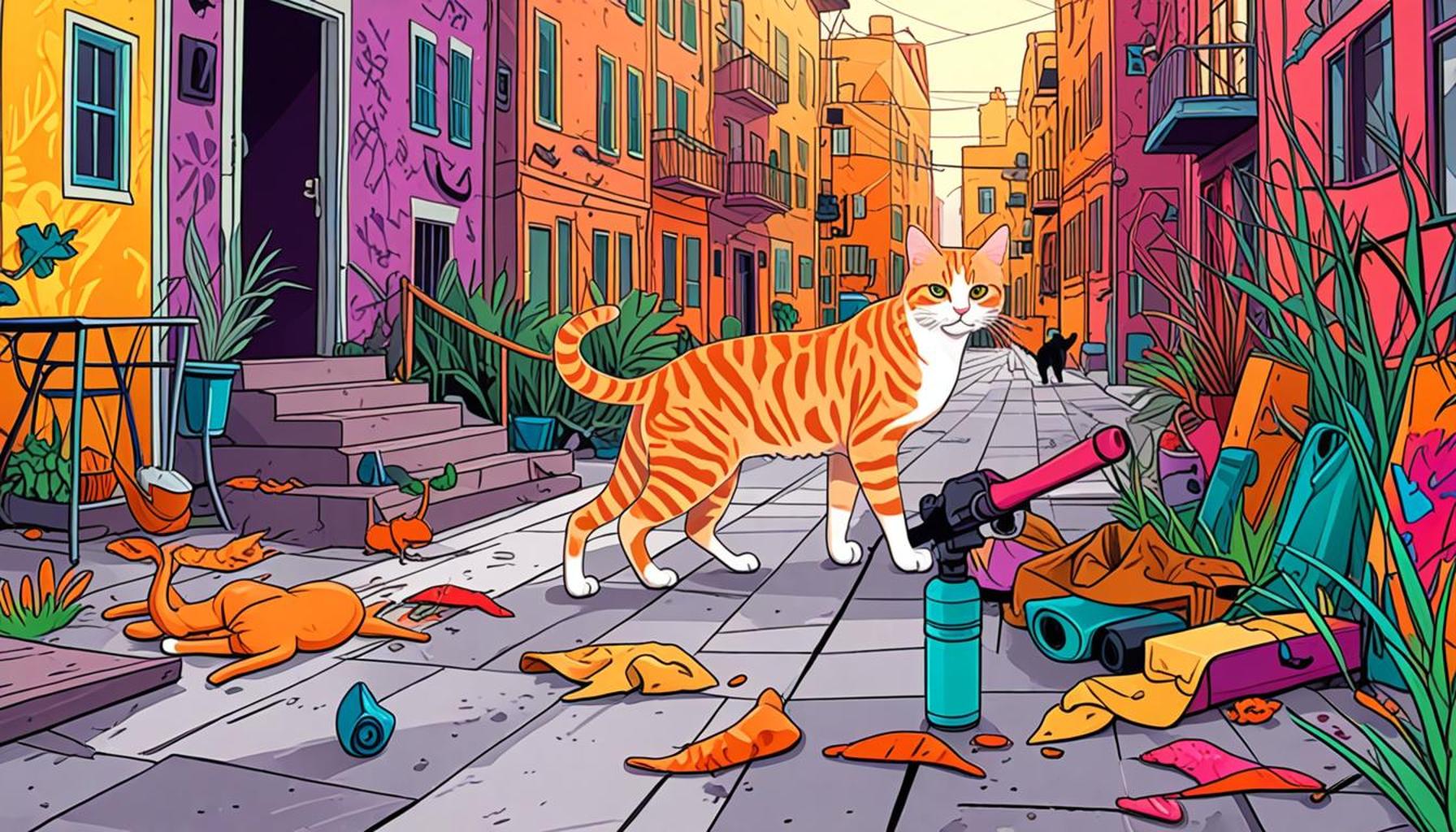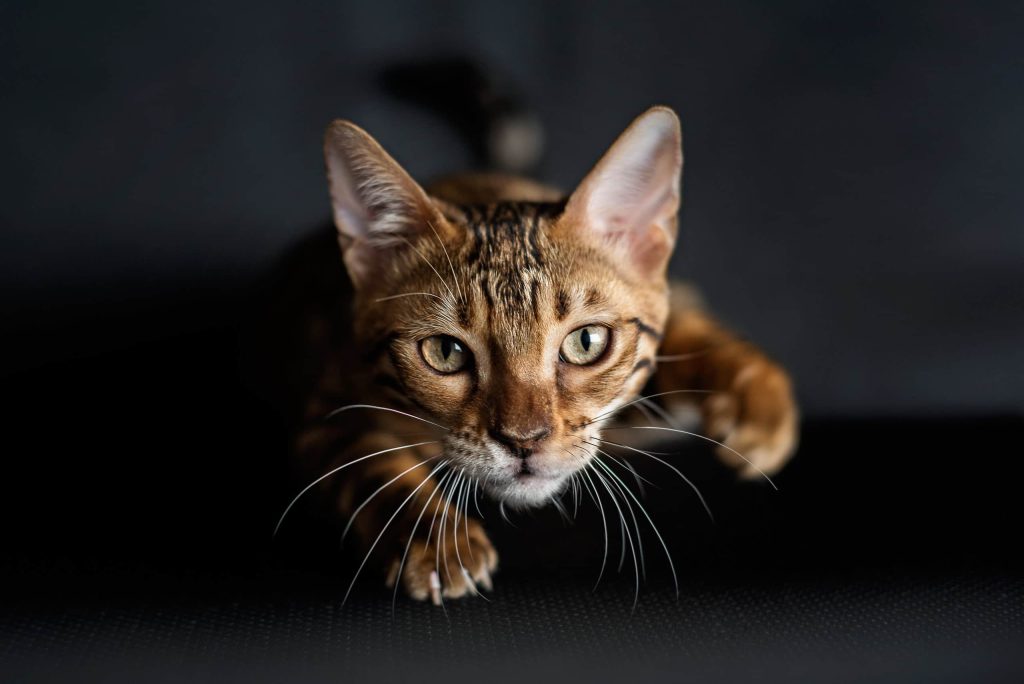Hunting Behavior in Domestic Cats: Natural Instincts in Urban Environment

Understanding the Complex Hunting Instincts of Domestic Cats
Domestic cats, despite their cozy lives as house pets, are natural hunters. Their instinctual behaviors remain intact, shaped by thousands of years of evolution. The predatory skills developed by their wild ancestors, such as the African wildcat, have significantly influenced their behavior even in modern settings. Observing how these instincts manifest in urban environments reveals fascinating patterns and nuances about their life and adaptability.
In urban environments, cats encounter both unique challenges and opportunities that significantly influence their hunting behavior. Understanding these elements helps us appreciate the complexity and adaptability of our feline friends.
Key Factors Influencing Urban Cat Hunting Behavior
- Prey Availability: Urban landscapes are surprisingly rich in prey options. Birds, rodents, and various insects often flourish in cities due to abundant vegetation, parks, and human refuse. A study from the American Bird Conservancy indicates that free-ranging domestic cats kill billions of birds each year, highlighting the significant impact of their presence on local wildlife. For example, cats hunt common urban species like sparrows and pigeons, which are attracted to areas with food sources such as trash and gardens.
- Hunting Techniques: Cats employ sophisticated tactics when hunting, favoring strategies such as stalking and pouncing. Even in a confined backyard, they exhibit remarkable stealth akin to that of a lion hunting in the wild. When a stray cat creeps through tall grass or around garden furniture, they can sometimes be seen crouching low to observe potential prey before darting forward in a quick burst of speed. This behavior not only reflects their predatory instincts but also provides them with much-needed exercise and mental stimulation.
- Environmental Adaptation: Urban cats must adapt to a myriad of stimuli, including busy streets, loud noises, and the presence of humans and other animals. They learn to navigate these challenges effectively, often becoming adept at hunting in less-than-ideal environments. For instance, a cat in a bustling neighborhood may target small rodents that forage near dumpsters, demonstrating an ability to exploit urban resources while minimizing risks.
Understanding these behaviors not only sheds light on the nature of domestic cats but also prompts important discussions. For instance, how do urban cats impact local wildlife? The ecological implications are significant, as their predation can lead to a decline in certain species. Additionally, their hunting practices offer insights into what cats require for their physical and mental well-being. This consideration drives a dialogue on responsible pet ownership and the importance of keeping cats indoors or within controlled environments.
This article delves deeper into the complex interplay between a cat’s innate hunting behaviors and the urban environment they inhabit. Join us as we explore the fascinating world of feline instincts, the challenges they face in cityscapes, and what their hunting patterns reveal about their needs and survival strategies.
LEARN MORE: Click here for insights on pet stress

Urban Hunting: Adaptations to City Life
As urban landscapes expand, domestic cats find themselves navigating a world filled with unique challenges and opportunities that shape their hunting behavior. Urban environments, often teeming with life, provide a complex interplay of stimuli and resources that influence how these feline predators hunt. Understanding these adaptations is crucial for pet owners and wildlife enthusiasts alike, as it reveals the dual nature of cats as both companions and impactful hunters.
One key aspect of urban cat hunting behavior is the availability of prey. Cities and suburbs host diverse populations of wildlife, including birds, rodents, and insects. Research from organizations such as the Center for Cats and Nature highlights that this urban wildlife often thrives close to human habitats. For example, backyards and parks serve as prime hunting grounds, attracting species like sparrows and chipmunks. The abundance of food sources, particularly from trash or poorly secured compost bins, allows cats to tap into their predatory instincts with ease, leading to significant hunting activity.
Prey Patterns in the Urban Jungle
- Small Mammals: Urban settings often provide homes for small mammals such as mice and voles. Their prevalence in gardens and green spaces makes them accessible targets for cats, especially at dusk or dawn, when these animals are most active.
- Bird Species: Birds that have adapted to urban life, such as house sparrows and rock pigeons, are frequently seen as easy prey for cats. Their attraction to city environments, often due to the availability of food, pits them against one of their most skilled predators—the domestic cat.
- Insects and Reptiles: Bugs like crickets, grasshoppers, and even small lizards provide additional hunting opportunities for cats. As cats chase down these smaller creatures, they satisfy their instinctual needs for both exercise and mental engagement.
The hunting techniques employed by domestic cats in urban areas showcase a brilliant adaptation to their environment. Each cat, from the housecat lounging on the windowsill to a feral feline roaming the alleys, exhibits keenly developed skills. While stalking and pouncing remain staples of their hunting technique, the urban setting adds layers of complexity. Cats demonstrate remarkable stealth, using natural cover like shrubs and garden furniture to approach their prey. Studies have noted that acumen for stealth not only exemplifies their skill as hunters but also plays a vital role in keeping them active and mentally stimulated.
Furthermore, as they navigate urban challenges, cats leverage the chaos of city life to their advantage. Being less fearful of the hustle and bustle, many cats adapt their hunting schedules to capitalize on rodent activity that often peaks around garbage disposal times. This remarkable adaptability helps them survive in an environment that constantly evolves.
By observing urban cats in action, we not only gain insight into their hunting behavior but also into the persistent connection to their ancestral instincts. This understanding invites an essential dialogue regarding responsible pet ownership and the implications of these behaviors for local wildlife. As we delve deeper into the fascinating interactions between domestic cats and their urban habitats, we uncover vital information about their needs and survival strategies within our cities.
| Hunting Techniques | Urban Adaptations |
|---|---|
| Stalking and Pouncing | Utilizing hidden spaces like bushes and alleys |
| Ambush Strategy | Leveraging urban noise for camouflage |
| Baiting | Attracting prey through sounds and movements |
| Chasing | Engaging in bursts of speed in open spaces |
The hunting behavior of domestic cats extends far beyond mere survival; it reflects a complex interplay of instinctual drives shaped by their urban environment. In cities, stalking and pouncing techniques often find their efficiency tested against the backdrop of high noise levels and bustling streets. Cats adapt their hunting styles to navigate urban landscapes, cleverly using hidden spaces like bushes and alleys to ambush potential prey.Interestingly, the ambush strategy is markedly effective in urban settings as cats can leverage the distracting sounds of city life to their advantage, becoming stealthy hunters among the chaos. An intriguing behavior observed is their use of baiting. Domestic cats show remarkable ingenuity in attracting prey—whether it’s playing with a leaf or mimicking the sounds of smaller animals.Within the urban wilds, the chase is not solely defined by speed, but rather by the strategic choice of when to unleash bursts of energy in open spaces. This fascinating adaptation of hunting behaviors underscores the innate capabilities of cats, revealing not just their natural instincts, but also their remarkable ability to thrive in urban environments. Each observed tactic contributes significantly to our understanding of feline behavior, enticing readers to delve deeper into the intricacies of their hunting habits.
LEARN MORE: Click here for essential vaccination tips
Cognitive Skills and Play: The Art of the Hunt
Beyond mere physical agility, domestic cats exhibit exceptional cognitive skills that influence their hunting behavior in urban environments. While most homeowners might categorize their pet’s playful antics as mere entertainment, these behaviors often mimic the essential hunting practices ingrained in their DNA. Play, especially in young cats, is a crucial element of their skill development. Research indicates that when kittens engage in mock hunts—stalking, pouncing, and batting at moving objects—they are honing the skills necessary for real hunting in adulthood.
Interestingly, many cat owners may overlook the significance of interactive play. Engaging with toys such as feather wands or laser pointers not only offers entertainment but also acts as a substitute for the beneficial hunting practice found in the wild. The mental stimulation garnered from these activities mimics the excitement of tracking and capturing prey, ensuring the cat remains sharp and active.
The Role of Territory and Social Dynamics
In urban environments, hunting behavior is also closely tied to territorial instincts and social dynamics among local feline populations. Cats are creatures of habit, and they often establish specific territories that they patrol consistently. This behavioral trait is vital for their hunting success, as a well-defined territory often ensures reliable access to food sources. A cat that claims dominion over a particular area becomes adept at knowing the rhythm of its prey and the fluctuations in availability.
Moreover, territorial battles or social interactions among cats — whether feral or domesticated — can directly influence their hunting strategies. Studies show that cats may modify their behavior based on their peers’ hunting success, leading to age-old challenges like the infamous ‘cat-astrophic rivalry.’ In neighborhoods with high feral cat populations, competition for resources can dictate hunting efficacy, leading some cats to adapt by hunting more early in the morning or late in the evening when fewer competitors roam the streets.
Human Interaction: Impact on Hunting Behavior
Interestingly, human presence can have a profound impact on the hunting behavior of domestic cats. The prevalent urban belief that indoor cats lead a sedentary life is increasingly being challenged. A study in the Journal of Feline Medicine and Surgery emphasizes that indoor cats, when provided with an enriched environment—complete with scratching posts, climbing trees, and window perches—exhibit a wide range of hunting behaviors, even without direct access to the outdoors. By simulating an outdoor experience, owners help cats foster their innate predatory instincts.
On the flip side, indoor-outdoor cats face heightened risks, including traffic and predation from larger animals. Thus, creating a safe environment that acknowledges their need to hunt while buffering them from dangers is crucial. Harnessed walks or supervised outdoor time can fulfill their natural instincts while maintaining their safety in urban areas.
In both cases, whether they are engaging in fierce battles for turf or gracefully stalking a sparrow, domestic cats reveal the depth of their hunting instincts and how these abilities are fine-tuned by their environment. The intersection of instinct and adaptability defines their urban existence, giving us further insight into the complexities of living alongside these fascinating creatures.
LEARN MORE: Click here for insights on pet nutrition
Conclusion
In summary, the hunting behavior of domestic cats in urban environments is a fascinating blend of instinctual practices and adaptive strategies. Cats navigate their concrete jungles through a delicate interplay of physical prowess, cognitive skills, and environmental influences. Their innate desire to hunt is evident in their playful interactions and territorial behaviors, which not only contribute to their overall well-being but also enhance their survival skills.
As urban dwellers, these feline companions face both new opportunities and challenges. The presence of human caretakers can significantly shape their hunting instincts, prompting pet owners to create enriched environments that stimulate their predatory behaviors even indoors. Ultimately, understanding their hunting instincts fosters a deeper appreciation for their natural needs and can lead to healthier, happier cats. Ensuring a safe outlet for these instincts, either through structured play or supervised outdoor experiences, is paramount in balancing their natural inclinations with the realities of urban living.
By recognizing the complexities of a cat’s hunting behavior, we not only enhance their quality of life but also underline the importance of coexisting harmoniously in our urban landscapes. As our cities evolve, so do the relationships we maintain with our feline friends, inviting us to explore even deeper understandings of what it means to be a cat in the modern world.


